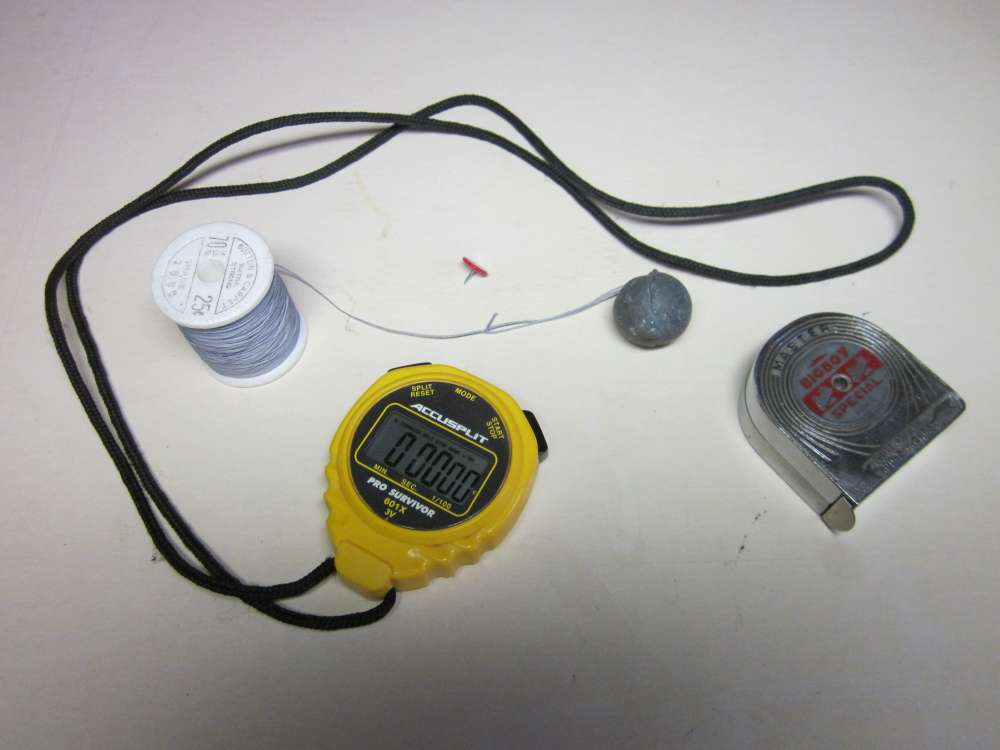Weight is an important quantity in science and engineering. Weight is the force that is produced when a mass is subject to gravity. Gravity is stronger at locations closer to the earth and less strong at locations farther from earth. An object will weigh more at the lowest point in Death Valley than at the summit of Mt. McKinley. Thus the weight of an object can vary from place to place. If we let something fall without resistance, it will accelerate at a steady rate, depending on the local strength of gravity. That rate can vary from location to location. We can easily measure the local gravitational acceleration with a simple pendulum and stopwatch.
Acceleration is the measure of a change in speed. Speed is measured in units of length per unit of time; for example, miles per hour or feet per second. Acceleration is thus has units of length per time per time; for example feet per second per second or meters per second per second. It may also be stated as feet per second squared. Length is in the numerator and time appears twice in the denominator.
A pendulum is a weight that is suspended from a fixed point by a filament so it can swing freely. When the weight is displaced from directly below the point of suspension, gravity acts to pull it back to the center. It will swing back and forth with a regular period that depends on gravitational acceleration, the length of the filament and slightly on the amplitude of the swing. For small amplitudes, the equation for the period of a pendulum is
t = 2 π √(l/g)
Divide l by g, take the square root, multiply that by π and multiply again by 2.
where
t = period of a complete swing, forward and back, in seconds
π = ratio of circumference to diameter of a circle, 3.1415926…
√ = square root
l = length of pendulum in feet (or meters)
g = local gravitational acceleration in feet (or meters) per second per second
You may wonder why the mass of the weight isn’t included in this equation. That is because gravity accelerates all masses the same. Every mass will produce the same measure of acceleration.

We can measure the period of a pendulum with a stopwatch and the length with a tape measure. By rearranging the equation, we can calculate g.
g = 4 π^2 l/t^2
Multiply the square of π by 4, multiply that by l and divide by the square of t.
^ = square the preceding number
To make a pendulum, you can suspend a fishing weight from a tack in the ceiling on a length of thread.
Measure the length of the pendulum from its point of suspension to the center of the weight: ______ ft.
Pull the weight just a little off center (about 1” will do) and release it. Start the stopwatch at the same time. Time how long it takes for the weight to return to its original position ten times: _____________ seconds. Divide that time by ten to get the length of one period:__________. Calculate the value of g: ___________ fpsps.
Do the same thing with displacements from the center of 3”, 6”, 12” and 24”. Compare the results.
Do the same for different lengths of the pendulum (using the small displacement). Plot a graph of period versus length. Does this support the equation?
It is important to know the difference between mass and weight. Mass is the inertia of the object, its resistance to acceleration. Weight is the force exerted by a mass under the influence of gravity. This important difference distinguishes two ways of weighing objects. When we weigh something on a balance, we are comparing it with a standard weight, both in the same gravity. When we weigh something with a spring scale, we are comparing the force exerted by local gravity with the extension force of the spring. The extension force of the spring does not depend on gravity. The weight shown by a balance will be the same everywhere. The weight shown by a spring scale will vary from location to location, depending on the local value of gravitational acceleration.